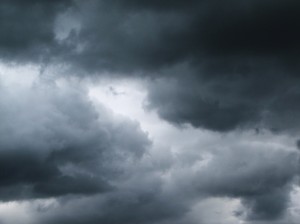Stormy weather, rainy weather, snowy weather, cold weather & your saxophone…..
Recently I wrote a guest post on StormHorn.com about saxophone and storms, a combination that surprised me a bit at first.
But that’s not what this post is about!
It’s not always sunny in California, though at the very southern tip in San Diego it is most of the time. Where I am at, it’s begun to rain.
As conditions start to get colder, the air will move through your saxophone slower. The air moving slower will lower the pitch of notes on the saxophone.
So the default position of your mouthpiece on the cork of the neck should be pushed a bit more in. Doing this decreases the length of the tube which increases the pitch overall on the saxophone. It will make your life easier if the you don’t have to fight as much to get proper intonation. Of course a lot of the adjustments for intonation happen internally.
If it’s cold enough, you won’t be able to push in any further and you’ll have to make do with being a little flat. As you warm up, things will get a bit better.
If it’s raining or snowing or worse, be extra careful about protecting your horn.
Your saxophone has a lot of small keys, pieces of cork, leather pads, and other parts. Compared to a trombone, there are a lot more things that can go wrong mechanically. See Saxophone Parts and Rocket Parts!
So you want to transport your sax with precaution and be wary of weather conditions if you’re playing outside.
Do you have any stories about saxophone and the weather? Leave a comment!




it seems that here in Colorado my reeds
tend to dry out quicker, and also as it gets
colder the dryer the reeds get, any suggestions
thanx in advance
Hey Barry,
That makes sense. It’s a little more humid where I am.
Experiment with different methods. For the issue of dryness: Some players keep their reeds wet constantly. I’ve seen them kept in a spice jar filled with vodka. I have also seen mouthpiece caps with little sponges on them to get them wet in between playing.
-Neal
My worst gig for intonation was many years ago, back when I was in high school and played in a big band called the “Formal Aires.” One winter weekend, we had a gig out on the Lake Michigan shoreline in Grand Haven in a hall that evidently didn’t have a furnace. The place was heated with a bunch of space heaters–a combination of burn barrels and some kind of jet-engine thingies. The room temperature fluctuated between literally freezing, at which point the heaters would kick on for a minute or two, and something that could have passed for reasonably warm, but not for long. You can imagine the impact on my intonation: now sharp, now flatter than an asphalt parking lot, and never in turn. No one could play in tune. The band sounded like a cement mixer.
Hey Bob,
Thanks for sharing the story, that is pretty crazy.
Any info on sunny and humid Florida? The summer here is brutal,and I was wondering what to do with reeds. Thank you. PS I enjoy your web site,very informative.
Sounds like it might be harder to dry reeds out in that case?
Personally, I keep mine wet all the time (using alcohol to kill germs). It takes some effort, but might be worth it for you.